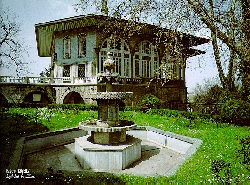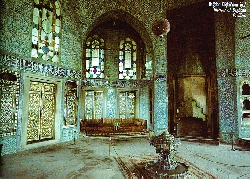

Baghdad Pavilion
Built in 639 by the architect Koca Kasim, this pavilion is also eight sided, and Surrounded by marble columns supporting a broad overhanging roof line, in a circular portico. Like the Revan, the lower walls are of marble and the upper walls of tiles. The mother - of pearl and tortoise shell inlay work in the doors, window frames, and closets in the interior are excellent examples of Turkish workmanship. The wall spaces throughout are totally covered in tile. From the heavily decorated dome hangs a golf - leafed sphere. Seating divans line the wall insets covered in velvet fabrics. The solid bronze fireplace blends with the massive tile bird figures on either side.
After visiting the Baghdad Pavilion, perhaps stopping for another look over the old city, we descend either of the staircases at the sides of the Revan Pavilion to the Fourth Court of the palace. On the left entering the court we pass the pavilion called the Sofa Pavilion, and further on the Mecidiye Pavilion. For an additional spectacular overlook of the city, the Bosphorus and the Marmara Sea, walk to the far side the Pavilion to its sea - side terrace. We now return to the third court, crossing opposite the Treasury to the Calligraphy Room, along side the Pavilion of the Holy Mantle. Here are displayed excellent examples of Islamic and Turkish writings over a long time period. Directly opposite its entrance stands the marble Library of Ahmet III (1718).

